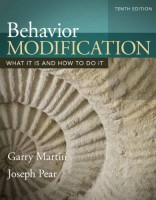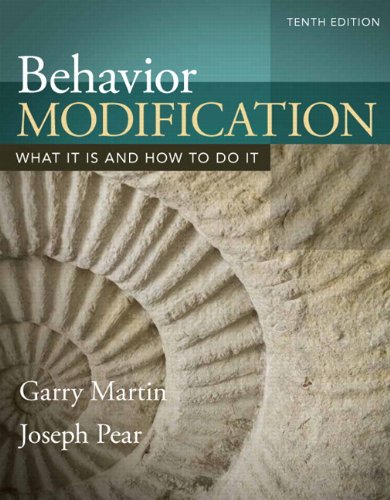 Authors: Garry Martin and Joseph Pear
Authors: Garry Martin and Joseph Pear
Publisher: Pearson – www.pearsonhighered.com – 365 pages
Book Review by: Sonu Chandiram
This book is about the roles that cognitive / behavior therapy and applied behavior analysis play in modifying behavior. It is also about the ways all of us influence others’ behavior. The authors point out that this book has been written for both undergraduate college students as well as those pursuing graduate-level studies on behavior modification. And outside of academia, the material can be well understood by the general reader. And there is enough to interest the serious scholar as well, especially in the Notes for Further Learning.
What will you find in this book? Thirty chapters of material on a wide range of topics: alcohol and other addictive behaviors, antecedent control, anxiety disorders, avoidance conditioning, behavior, behavior assessment, behavior chaining, behavior modification, behavior modification research, behavior therapies, behavioral persistence, behavioral principles, behavioral procedures, behavioral programs, behavioral sport psychology, community behavioral analysis, conditioned reinforcement, couple distress, decreasing operant behavior, depression, developmental disabilities, differential reinforcement;
Also: eating disorders, education from preschool to university, ethical issues in behavior, escape conditioning, fading behavior, functional assessment of problem behavior, generality of operant and respondent behavior, gerontology, habit disorders, operant conditioning, operant extinction, parenting and child management, Pavlovian orientation, phobias, positive reinforcement, punishment in behavior, psychological disorders, reflexive behavior, respondent conditioning, schedules of reinforcement, schizophrenia, shaping behavior, self-management, sexual dysfunction, stimulus control, stimulus discrimination, stimulus generalization, Wolpean orientation.
The 30 chapters have been organized around these seven Parts:
- The Behavior Modification Approach
- Basic Behavioral Principles and Procedures
- Capitalizing on Antecedent Control Principles
- Dealing with Data
- Putting It All Together to Develop Effective Behavioral Programs
- Behavior Therapy for Psychological Disorders
- A Historical Perspective and Ethical Issues
The material in the chapters has been organized for easy learning and retention. The chapters begin with a box entitled Learning Objectives which simply states: “After studying this chapter, you will be able to,” (itemizing the tasks, e.g. in chapter 1):
- Define behavior, behavior modification, behavioral assessment
- Describe how behavior modifiers view traditional psychological concepts such as intelligence and creativity
- Summarize historical highlights of behavior modification
- Discuss the relationship between behavior modification, applied behavior analysis, and behavior therapy
- State some common misconceptions about behavior modification
Such an active approach to learning requiring students to recall and recite what they learned in the chapters is a very effective method of teaching. This is one of the ways the author uses to ensure that the students and readers have actually learned what they have read.
Chapter 1, like other chapters, present real-life examples of problem behaviors. He gives seven examples of such behavior and explains what is happening. We itemize them below but mention what is happening only in the first example:
- Withdrawn behavior. A class of nursery school youngsters is in the playground. While most of the children are playing, one little behavior who has been diagnosed with autism sits quietly by himself, making no effort to join in the fun.
- Ineffective studying
- Performance nervousness
- Campground littering
- Migraine headaches
- Staff management
- Irrational thinking
Topics are often presented and discussed in the chapters with questions, such as “What is Behavior?” in the first chapter. This is followed by sections entitled Questions for Learning. Other topics follow, headed by questions, such as “What is Behavior Modification?” and “What is Behavioral Assessment?” Each of these discussions is followed by Questions for Learning. These are examples of a very proactive approach the authors have taken in this book.
Garry Martin is affiliated with St. Paul’s College in Winnipeg in Manitoba, Canada.
Joseph Pear is affiliated with the University of Manitoba in Canada.







